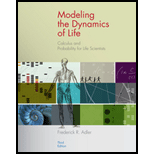
Concept explainers
(a)
To find the population of bacteria after
(a)
Answer to Problem 57E
Therefore, the population after
The population after
The population after
Explanation of Solution
Given information:
Calculation:
Suppose a population of bacteria with the initial condition
However,
Now, the population after
Therefore, the population after
Now, the population after
The population after
Again, the population after
The population after
(b)
To find how many bacteria were harvested based on the given data.
(b)
Answer to Problem 57E
Explanation of Solution
Given information:
Calculation:
Since there are three harvests of
Hence, the total number of bacteria that were harvested is
(c)
To write the discrete-time dynamical system using the obtained values
(c)
Answer to Problem 57E
Explanation of Solution
Given information:
Calculation:
As the population of bacteria doubles every hour and
(d)
To find how many bacteria could be removedin the population
(d)
Answer to Problem 57E
There would be
Explanation of Solution
Given information:
Calculation:
Now, ifwe wish to harvest bacteria until the end of
Hence, there would be
So, we can harvest
Again, the bacteria removed early never had a chance to reproduce.
Want to see more full solutions like this?
Chapter 1 Solutions
Modeling the Dynamics of Life: Calculus and Probability for Life Scientists
- The table shows the distribution, by age, of a random sample of 3160 moviegoers ages 12-74. If one moviegoer is randomly selected from this population, find the probability, expressed as a simplified fraction, that the moviegoer is not in the 65-74 age range. The probability is (Type an integer or a simplified fraction.) Age Distribution of Moviegoers Ages Number 12-24 1090 25-44 860 45-64 890 65-74 320arrow_forwardUse the spinner shown. It is equally probable that the pointer will land on any one of the six regions. If the pointer lands on a borderline, spin again. If the pointer is spun twice, find the probability that it will land on yellow and then yellow. Find the probability that the spinner will land on yellow and then yellow. The probability is (Type an integer or a simplified fraction.) Green Red Gray Red Blue Yellow Q ☑arrow_forwardUse the spinner shown to answer the question. Assume that it is equally probable that the pointer will land on any one of the colored regions. If the pointer lands on a borderline, spin again. If the spinner is spun once, find the probability that the pointer lands in a region that is red or green. The probability that the pointer lands in a region that is red or green is (Type an integer or a simplified fraction.) green red green red yellow redarrow_forward
- Let $f(x)$ be a continuous function on the interval $[0,1]$ such that $f(0) = f(1) = 0$. Prove that for any positive integer $n$, there exists a real number $x$ in $[0, 1 - \frac{1}{n}]$ such that $f(x) = f(x + \frac{1}{n})$.arrow_forwardK/FT イ 5 SLOPE AB TB3.3 C 15 TROY 16.7 y Yo 13.3 GIVEN: BEAM + LOADING DRAW V+H SOLUTION: DIAGRAMS 1) FIND REACTIONS R=14/15 (20) = 20k (@EMB=20F (5) - Roy(15) RRY = 6.7k EFу=0= 20+67+RBY RBY = 13.3k+ 5 6.7 roarrow_forwardQuestion 1: (10 points) Determine whether the following Realation is an Equivalent Relation or not, and show the reason for your answer. If A={1,0} R= {(1,1), (0,0), (1,0), (0,1)}arrow_forward
- whats this answer Ginger records her grades for each assignment in science.arrow_forwardSolve the following initial value problem the initial conditions aw +3. = 12z+18 +9, Əz2 მი w(x, 0)=2x3+3x²+8x ду From (38) auction we obtain follow (x, 0) =i (6x²-6x+2).arrow_forwardQuestion 1 20 pts Test data on the bending strength of construction wood poles of various diameter are presented below assuming the same length. Kip- 1000 lbf. Using the following data with 2nd order Newton polynomial interpolation, we want to determine the strength of the material for x=4.9 in. Which data point will be used as x? After you found x0, enter the value of x-xo in the solution. Answer shall be in one decimal place. Distance (in) Strength (kips) 100 3.6 1.1 5.6 3.6 5.6 200 300 400 500arrow_forward
- Test data on the bending strength of construction wood poles of various diameter are presented below assuming the same length. Kip- 1000 lbf. Using the following data with 2nd order Newton polynomial interpolation, we want to determine the strength of the material for x=4.3 in. Which data point will be used as x0? After you found x0, enter the value of x-xo in the solution. Answer shall be in one decimal place. Distance (in) Strength (kips) 100 2.7 1 6.8 0.6 5.7 200 300 400 500arrow_forward2/2. prove that if G is Euler then so is L (G).arrow_forwardQ10. What are the chromatic numbers of the following two graphs? G H A. x(G) = 2 and x(H) = 2 B. x(G) = 2 and x(H) = 3 C. x(G) = 3 and x(H) = 2 D. X(G) = 3 and x(H) = 3 E. x(G) = 4 and x(H) = 3arrow_forward
- Algebra & Trigonometry with Analytic GeometryAlgebraISBN:9781133382119Author:SwokowskiPublisher:Cengage

 Linear Algebra: A Modern IntroductionAlgebraISBN:9781285463247Author:David PoolePublisher:Cengage Learning
Linear Algebra: A Modern IntroductionAlgebraISBN:9781285463247Author:David PoolePublisher:Cengage Learning  Big Ideas Math A Bridge To Success Algebra 1: Stu...AlgebraISBN:9781680331141Author:HOUGHTON MIFFLIN HARCOURTPublisher:Houghton Mifflin Harcourt
Big Ideas Math A Bridge To Success Algebra 1: Stu...AlgebraISBN:9781680331141Author:HOUGHTON MIFFLIN HARCOURTPublisher:Houghton Mifflin Harcourt College AlgebraAlgebraISBN:9781305115545Author:James Stewart, Lothar Redlin, Saleem WatsonPublisher:Cengage Learning
College AlgebraAlgebraISBN:9781305115545Author:James Stewart, Lothar Redlin, Saleem WatsonPublisher:Cengage Learning




